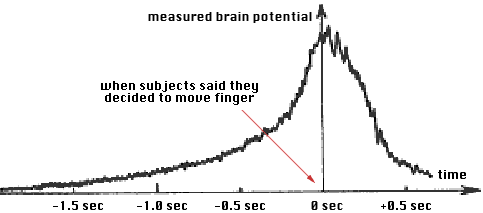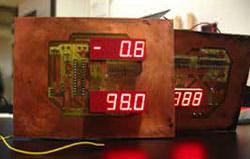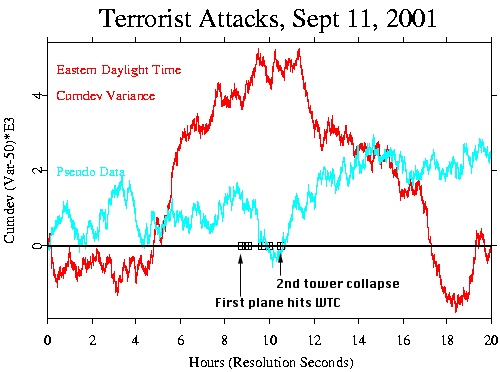Sign up before Midnight to watch our video,
“Biggest Ponzi Scheme in U.S. History to Crash,”
and get our daily e-letter Investment Contrarians.
We respect your privacy!
We will never rent/sell your e-mail address.
That’s a promise! And you can opt out at any time.
On September 11, 2001, the normally flat line of the boxes began to peak, warning of an event of terrible proportions a full 4 hours before the first plane hit the World Trade Center! Could the collective human mind have “known” what was going to happen?…
I am a skeptic. I don’t believe in fortune tellers or psychics. I certainly doubted that I could forsee the future. But, as I did the research for this article, I discovered that I was wrong.Everyone can see into the future and we do it all the time.
Ooop! That wasn’t supposed to happen
Our journey starts with an experiment conducted in 1976. Dr. Kornhuber asked a number of volunteers to be wired with EEG electrodes to measure their brain activity. He then asked the volunteers to flex the index finger of their right hand, suddenly and at various times of their own choosing. He wanted to measure how fast it took for the mental decision to move the finger to actually make the finger move. His results were not what he expected.
Kornhuber expected to find a sharp peak in electrical activity when the decision was consciously made, at which point he would begin timing the trials. However, what he found is remarkable, namely that there is a gradual build-up of recorded electric potential for a full second, or perhaps even up to a second and a half, before the finger is actually flexed. This seems to indicate that the conscious decision process takes over a second in order to act! Even more surprising was that the volunteers were not aware of this delay and believed they were acting spontaneously and instantly.

So what happened? Did the brain somehow “know” that the decision would be made in the future and begin planning the action?
The experiment received little attention until another experiment conducted by Dr. Libet in 1979 raised questions about our conscious perception of time and the idea of “now.”
Everything “now” happened already!
Libet tested subjects who had to have brain surgery for some reason unconnected with the experiment and who consented to having electrodes placed at points in the brain, in the somatosensory cortex. He monitored the electrical activity while stimulating their skin. To his amazement it took about a half-second before the subjects were able to perceive the stimulation. Further experiments showed that this same delay — about a half second — was needed for all sensory input to reach consciousness.
The significance of this is enormous. Everything we know about the external world right now — the sounds, the sights, the feelings — are all being delayed. Everything that you think is happening right now actually happened already, about half a second ago!
So how is this possible? How do we drive cars, catch baseballs, swat flies and write or draw if it’s all delayed? Well, the obvious answer is that we have adapted the ability to compensate for the delay by projecting our behavior into the future, which is really “now.”
Confusing? Wait… It gets even better.
Five Seconds In The Future
Marilyn Schlitz connected volunteers to a series of monitors, similar to a lie detector, to measure their heartbeat, perspiration and other nervous activity. She then had them sit in front of a computer screen and began showing them a series of images which were selected at random by the computer from a large collection. These images were described as either “neutral” (boring) or “emotional” (erotic or morbid). As expected, the subjects showed physical and mental excitement when the “emotional” images were shown and showed less reaction to the “neutral” images. But as the experiment continued, something weird happened.
Researchers began to see that most people, unconsciously, began to react to the “emotional” images a full 5 seconds before they were selected by the computer program! What’s more, they did not react to the “neutral” images. This result was statstically significant (p=0.00003) and has been repeated many times. It strongly suggests hat subjects can perceive the future.
Researchers began to see that most people, unconsciously, began to react to the “emotional” images a full 5 seconds before they were selected by the computer program! What’s more, they did not react to the “neutral” images. This result was statstically significant (p=0.00003) and has been repeated many times. It strongly suggests hat subjects can perceive the future.
Another study, described in the Journal of Alternative and Complementary Medicine, was reported by psychophysiologist Rollin McCraty and his colleagues from the Institute of Heartmath in Boulder Creek, California. McCraty’s group simultaneously measured skin conductance, heart rate, and brainwave activity before, during, and after 26 participants viewed emotional and calm pictures. They found that both the heart (p < 0. 001) and the brain (p < 0. 05) responded about 5 seconds before the future emotional stimuli, and to their amazement, that the heart responded before the brain. they also observed significant gender differences in the processing of this future information (women performed better, on average, than men). they concluded: “Our findings suggest that intuitive perception is not a discrete function produced by a single part or system of the body alone. Rather, it appears that intuition may in fact be a system-wide process involving at least the heart and brain, together, in the processing and decoding of intuitive information.” They highlighted that “the fact that the heart is involved in the perception of a future external event is a surprising, even astounding result, especially from the classical perspective that assigns the brain an exclusive role [for perception].”
How do you feel?
Here are eight pictures, some neutral and some emotional. Before you view each image, try to sense how you feel. Is the picture neutral or emotional? This isn’t a real test but it will give you an idea how the actual experiment worked and felt.
Future global consciousness
Five seconds isn’t a long time to see into the future. It doesn’t allow you to pick tomorrow’s lottery number or predict the headline. But there is strong evidence that this ability to see future events may extend for several hours.
Dr. Roger Jahn from Princeton University developed a small computer (the Random Event Generator or “black box”) that generated random numbers. The numbers were converted to either “1″ or “0″ and were recorded over various time intervals. The device was similar to flipping a coin and resulted in an equal number of “1s” and “0s.”
The pattern of ones and noughts — ‘heads’ and ‘tails’ as it were — could then be printed out as a graph. The laws of chance dictate that the generators should churn out equal numbers of ones and zeros — which would be represented by a nearly flat line on the graph. Any deviation from this equal number shows up as a gently rising curve.
 During the late 1970s, Jahn decided to investigate whether the power of human thought alone could interfere in some way with the machine’s usual readings. He hauled strangers off the street and asked them to concentrate their minds on his number generator. In effect, he was asking them to try to make it flip more heads than tails.
During the late 1970s, Jahn decided to investigate whether the power of human thought alone could interfere in some way with the machine’s usual readings. He hauled strangers off the street and asked them to concentrate their minds on his number generator. In effect, he was asking them to try to make it flip more heads than tails.
It was a preposterous idea at the time. The results, however, were stunning and have never been satisfactorily explained.
Dr Nelson, also working at Princeton University, then extended Prof Jahn’s work by taking random number machines to group meditations, which were very popular in America at the time. Again, the results were eyepopping. The groups were collectively able to cause dramatic shifts in the patterns of numbers.
From then on, Dr Nelson was hooked.
Using the internet, he connected up 60 random event generators from all over the world to his laboratory computer in Princeton. These ran constantly, day in day out, generating millions of different pieces of data. Most of the time, the resulting graph on his computer looked more or less like a flat line.
 But then on September 6, 1997, something quite extraordinary happened: the graph shot upwards, recording a sudden and massive shift in the number sequence as his machines around the world started reporting huge deviations from the norm. The day was of historic importance for another reason, too. It was the day when over one-billion people, from all around the globe, watched the funeral of the loved Diana, Princess of Wales at Westminister Abbey and millions participated in delivering flowers by post UKto her funeral site.
But then on September 6, 1997, something quite extraordinary happened: the graph shot upwards, recording a sudden and massive shift in the number sequence as his machines around the world started reporting huge deviations from the norm. The day was of historic importance for another reason, too. It was the day when over one-billion people, from all around the globe, watched the funeral of the loved Diana, Princess of Wales at Westminister Abbey and millions participated in delivering flowers by post UKto her funeral site.
It seems that, without making a conscious effort to focus on the “black boxes,” the collective psyché of humanity was able to change the random pattern. This amazing event prompted Nelson to install the “black boxes” in 41 different countries around the globe and wire them together over the internet so that the collective results could be instantly monitored. And this is when he noted something even more extraordinary.
Something happened just prior to 9-11-2001 also!
On September 11, 2001, the normally flat line of the boxes began to peak, warning of an event of terrible proportions a full 4 hours before the first plane hit the World Trade Center! Could the collective human mind have “known” what was going to happen?

According to the researchers:
 “One way to think of these startling correlations is to accept the possibility that the instruments have captured the reaction of a global consciousness beginning to form. The network was built to do just that: to see whether we could gather evidence of a communal, shared mind in which we are participants even if we don’t know it.
“One way to think of these startling correlations is to accept the possibility that the instruments have captured the reaction of a global consciousness beginning to form. The network was built to do just that: to see whether we could gather evidence of a communal, shared mind in which we are participants even if we don’t know it.
Groups of people, including the group that is the whole world, have a place in consciousness space, and under special circumstances they — or we — become a new presence. Based on evidence that both individuals and groups manifest something we can tentatively call a consciousness field, we hypothesized that there could be a global consciousness capable of the same thing. Pursuing the speculation, it would seem that the new, integrated mind is just beginning to be active, paying attention only to events that inspire strong coherence of attention and feeling. Perhaps the best image is an infant slowly developing awareness, but already capable of strong emotions in response to the comfort of cuddling or to the discomfort of pain.”
 In the last weeks of December 2004 the various “black boxes” again went crazy, showing dramatic peaks while everything seemed peaceful and calm. Just 24 hours later, an earthquake deep beneath the Indian Ocean triggered the tsunamiwhich devastated South-East Asia, and claimed the lives of an estimated quarter of a million people. Was this another example of “future shock?”
In the last weeks of December 2004 the various “black boxes” again went crazy, showing dramatic peaks while everything seemed peaceful and calm. Just 24 hours later, an earthquake deep beneath the Indian Ocean triggered the tsunamiwhich devastated South-East Asia, and claimed the lives of an estimated quarter of a million people. Was this another example of “future shock?”
Several other historical “emotional” events have been recorded by this method and continue to suggest that the effect is real, yet still unexplained. The boxes are now monitored and studied by the Global Consciousness Project and the results and graphs for past and present are made available to the public at the website.
What’s happening right now in the world?
What color is this dot?
[The dot is updated every minute. It's usually green or yellow. If it changes to orange or red... something bad may happen!]
The color coding represents the level of coherence or correlation among the eggs, which is reflected in the probability of the Chisquare. The expected level is about 50%, and big shifts in either direction are notable. The GCP’s formal testing looks for increased interegg correlation, which is represented here by the warm colors, orange and red. That means something’s disturbing the global consciousness… possibly indicating that something bad is about to happen!
- Blue starts to fade in at 90% and above.
- Green represents about 50%
- Yellow starts fading in from green at 40%.
- Orange fades in at 15% or so.
- Red is 5% which is regarded as “significant”.
- Bright red is 1%, or odds of 1 in 100.
Click on the dot for more details.
What does this mean?
Since out nervous system is hard wired with a delay of about one half of a second, we have had to develop the ability to anticipate the future. This function is not only beneficial but vital to our survival. Hand-eye coordination and avoiding danger in the “real time” world demand that we have this ability. It is not surprising then that this ability should extend beyond a half-second, perhaps diminishing as it extends toward the future. It is also possible that this ability can be concentrated from a group or collection of human minds in way that we have not yet tested.
Spiritualists value collective prayer and meditation as an effective force to change nature or petition higher powers. Until now the ability to see the future has been considered mystical or paranormal. Now, with the recognition that this ability is innate to humanity, perhaps we can develop and refine it to make a better world and a more pleasing future for our species.
Sign up before Midnight to watch our video,
“Biggest Ponzi Scheme in U.S. History to Crash,”
and get our daily e-letter Investment Contrarians.
We respect your privacy!
We will never rent/sell your e-mail address.
That’s a promise! And you can opt out at any time.